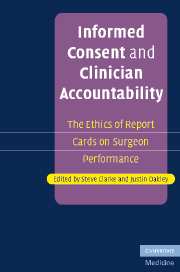Book contents
- Frontmatter
- Contents
- List of contributors
- Acknowledgements
- Introduction: Accountability, informed consent and clinician performance information
- Part I Accountability
- Part introduction
- 1 Clinician report cards and the limits of evidence-based patient choice
- 2 Report cards for institutions, not individuals
- 3 Safety, accountability, and ‘choice’ after the Bristol Inquiry
- 4 Public reports: putting patients in the picture requires a new relationship between doctors and patients
- 5 Adverse event disclosure: benefits and drawbacks for patients and clinicians
- 6 Report cards and performance monitoring
- Part II Informed consent
- Part III Reporting performance information
- Index
- References
4 - Public reports: putting patients in the picture requires a new relationship between doctors and patients
Published online by Cambridge University Press: 08 August 2009
- Frontmatter
- Contents
- List of contributors
- Acknowledgements
- Introduction: Accountability, informed consent and clinician performance information
- Part I Accountability
- Part introduction
- 1 Clinician report cards and the limits of evidence-based patient choice
- 2 Report cards for institutions, not individuals
- 3 Safety, accountability, and ‘choice’ after the Bristol Inquiry
- 4 Public reports: putting patients in the picture requires a new relationship between doctors and patients
- 5 Adverse event disclosure: benefits and drawbacks for patients and clinicians
- 6 Report cards and performance monitoring
- Part II Informed consent
- Part III Reporting performance information
- Index
- References
Summary
Should report cards on surgeon performance be publicly available? Yes, but only if the information is presented in ways that can be easily understood by consumers and patients. The merits of public reports or provider profiles have been constantly debated since their first appearance in the public domain in the early 1990s. Some of the arguments against reporting include the potential to misinterpret data, the lack of clarity about what is counted and the potential the information may have in lowering staff morale. Better consumer choice, greater clinical accountability and improved quality are arguments in support of public reporting. But missing in this debate is the need to prepare and enable patients to make real choices about their doctors or hospitals.
system not designed for patient choice
Many patients lack genuine choices in healthcare either because of the nature of their disease or because the health system is yet to recognize the scope of the informational needs of patients and their obligations to provide it. A redesigned health system is required if patients are to have genuine choice in their healthcare. The way the health system is currently structured and organized relies on patients being passive receivers of their healthcare.
Report cards about surgeons' performance have been available to patients for more than a decade, yet the evidence is that patients rarely use them to choose their surgeons or hospitals (Marshall, 2001; Schneider and Lieberman, 2001).
- Type
- Chapter
- Information
- Informed Consent and Clinician AccountabilityThe Ethics of Report Cards on Surgeon Performance, pp. 65 - 75Publisher: Cambridge University PressPrint publication year: 2007
References
- 4
- Cited by



